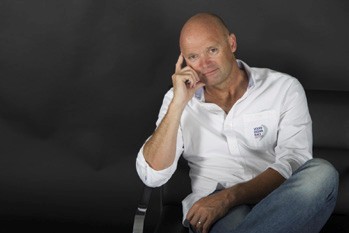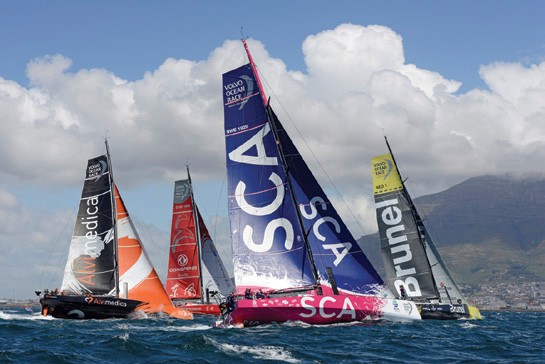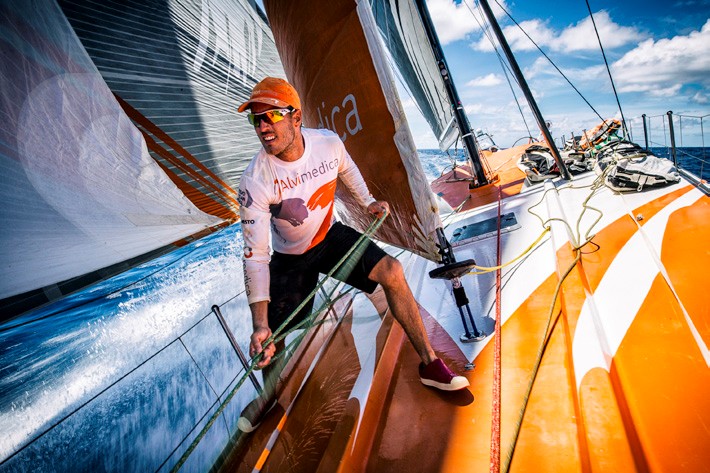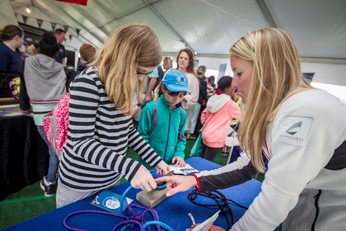 One of the most respected figures in professional sailing, Mark Turner was appointed CEO of the Volvo Ocean Race in 2016. The 49-year-old Briton competed in the race aboard British Defender in 1989 when it was known as the Whitbread Round the World Race, and he led the Dongfeng Race Team campaign in the 2014-25 edition.
One of the most respected figures in professional sailing, Mark Turner was appointed CEO of the Volvo Ocean Race in 2016. The 49-year-old Briton competed in the race aboard British Defender in 1989 when it was known as the Whitbread Round the World Race, and he led the Dongfeng Race Team campaign in the 2014-25 edition.
The Volvo Ocean Race is in Mark Turner’s very capable hands. © Ainhoa Sanchez/Volvo Ocean Race
A veteran of other premier offshore events including the Transat Jacques Vabre and the Mini Transat, Turner managed Ellen MacArthur’s Vendée Globe in 2001, in which she finished second, and masterminded her record-breaking non-stop solo circumnavigation in 2005.
The 13th edition of the Volvo Ocean Race starts in October in Alicante, Spain. At nearly 45,000 nautical miles, the route is the longest in the 44-year history of the event that was born as the Whitbread in 1973. And with many more miles in the Southern Ocean as the previous editions, this will likely be the toughest VOR yet. We spoke with Turner about what’s in store for the 2017-18 edition.
WindCheck: Why did you decide to lengthen the racecourse, and how will the additional miles in the Southern Ocean change the event?
Mark Turner: Our decision around the route was driven by a desire for more action, more tough miles, more speed and more world-class host cities. The route we’ve chosen takes in something like 12,500 nautical miles in the Southern Ocean – about three times as much as in previous editions. The sea around the Antarctic is a big part of the Race’s heritage and we feel spending so much more time there, amid huge waves and heavy winds, takes us back to roots of the race in the old Whitbread days.
In terms of stopovers, 2017-18 will see us visit some of the world’s most famous sailing cities – places like Cape Town, South Africa, Auckland, New Zealand and Newport, Rhode Island – where there is always great engagement from the public.
Have you commissioned any studies on crew stress levels from the last race? If so, what were the findings and what actions are you taking?
The Volvo Ocean Race hasn’t commissioned a particular study since the last race, although Team Alvimedica carried out quite extensive crew health checks after every leg to assess both physical and mental stress and fatigue. The teams entering the Volvo Ocean Race are fully professional sports campaigns and they take seriously the side effects of things like sleep deprivation, stress management. The coaches involved take this into consideration in preparing the team for the race and keeping them going through to the finish line. On the last race with Dongfeng Race Team, the sailing coach also acted as the team’s psychologist.
For the 2017-18 edition, we are certainly interested in continuing this kind of work in a more formalized way and have already been contacted by leading professionals who are interested in making a study with the teams in the race.

The one-design Volvo Ocean 65s are undergoing refits to improve reliability for the 2017-18 edition.
© Rick Tomlinson/Team SCA
What changes have you made to the scoring system, and how will that improve the competition?
One of the most fantastic things about the move to One-Design in 2014-15 was that we had extraordinarily close racing all the way around the world – but there was also a bit of a ‘sheep’ mentality, with no one really wanting to break from the fleet for fear of being left behind, and instead just wanting to play the averages.
We needed to do something to encourage that strategic risk-taking. We’re changing the points system to a high-point system, then the two Southern Ocean legs are double points legs as is the North Atlantic leg from Newport to Cardiff, and that coming near the end of the race will hopefully keep the competition for the podium wide open. We’ve incorporated a single bonus point for every leg win and for the first team round Cape Horn and, finally, a bonus point for the team with the best total elapsed time. But we’re also considering things like blackouts in terms of positions, so teams can go into ‘stealth’ mode, and in terms of weather data provided, so that navigators need to use more of their own judgment at certain times.
What were the discussions that led to the new rules for mixed teams, particularly in terms of the weight difference between a 7-person crew and an 11-person crew and the extra food, gear, life rafts, etc.?
We were facing a situation that without an all-female campaign – and that wasn’t on the radar – we could have a race with no female competitors and that just seemed like a massive step backwards after the performance of Team SCA in the last edition. So by devising a crew limitation rule for all-male teams, this opened up some interesting combinations that will ensure women get to race. The potential crew combinations are seven all-male crew, seven men plus one or two women, five men and five women, or 11 all-female.
The crew combination can vary per leg, so that adds another strategic layer and the teams will have to weight up the pros and cons of taking more crew on certain legs including the weight implications of extra food and gear. Although we know from the last race that even though Team SCA raced with 11 crew, the combined weight of gear and food was lighter than that of the all-male teams as they actually need less food than the guys. The life rafts on each boat can take a maximum of 12 persons so there is no issue there.
Will the new rule inspire more women to compete in the 2017-18 edition?
There are a whole bunch of female sailors today who can add value to a Volvo Ocean Race campaign, and everyone recognizes that the only way the women can compete without the need for a rule is for them to gain experience. The same ethos applies to younger sailors, which is why we have the Under 30 Rule as well. There are plenty of professional male sailors who have thousands of ocean miles, including Southern Ocean miles, under their belts so they, naturally, are top of the selection process. The female sailors and young sailors need to gain that same kind of experience.
Undoubtedly, seeing the women compete with the guys will naturally inspire many other female sailors to follow their course. The Volvo Ocean Race remains one of the top three in the sport of sailing alongside the America’s Cup and the Olympics. Now we are seeing more and more sailors finish their Olympic campaigns and going ‘What next?’ Both the America’s Cup and the Volvo Ocean Race are viable options for them.
How will the new hydropower units on the Volvo Ocean 65s help the race achieve its goal of energy neutrality?
Sailing as a sport has a responsibility toward the environment. We are not there yet to achieve Energy Neutrality, but it is something we are going to proactively work on. This edition of the race will be used to test different products that can be used in the future.
Please describe how the many other aspects of the ongoing refits (composites, spars, deck gear, electronics, engineering, etc.) will make the boats stronger, safer and faster.
Reliability is our key requirement for the refit. We aim to put the fleet of Volvo Ocean 65s back on the start line in the next edition of the race with the same reliability that we had in the last race. During the refit we are also working closely with all our suppliers to not only upgrade their equipment, but also take advantage of their development during the last few years to ensure we stay on the cutting edge of technology. Whilst the hulls of the boats may be the same as the last edition, we continue to innovate with our suppliers. Speed is of course a critical aspect; any speed gains will come from a complete new wardrobe of sail shapes and designs from North Sails.

Team Alvimedica bowman Nick Dana of Newport, Rhode Island performs a sail change near the Equator.
© Amory Ross/Team Alvimedica
How will the revised Onboard Reporter program enhance event coverage?
We believe that creating a squad of multimedia reporters that are able to work across the fleet instead of being permanently attached to individual teams will enhance the coverage. It is a difficult task of balancing integrity and acquiring sufficient trust of the sailors but with no permanent attachment to one particular team, the OBR can be more impartial and focus on his role as an observational reporter.
Is the race followed as widely and enthusiastically in China as in other countries, especially since the Dongfeng Race Team won two legs and finished third overall in the 2014-15 edition?
For sure, the Dongfeng Race Team gained some good traction in China but we are only scratching the surface in terms of public engagement. Although China has a great maritime heritage very few people sail, but the success of the Chinese Olympic sailors over the last decade or so has helped elevate the sport. Ultimately, the Volvo Ocean Race is not just a sailing story; it is an unbelievable story of human endeavor and I believe we can connect with a new audience that way.
What is Volvo’s goal for this race? What do they continue to look for and get from it?
Although the race is jointly owed by Volvo Group which includes Trucks, Bus, Construction Equipment, Penta and Volvo Cars, the motivation for being involved is quite similar between the two. It is about building their brands and associating with values that are naturally delivered by the race, such as adventure, emotion, performance, innovation and teamwork. They use the Volvo Ocean Race as a storytelling tool for their own brands. As a global business platform, both B2B and B2C, it is hugely effective. In 2014-15, Volvo invited around 21,000 guests to the stopovers and over 2.4 million members of the public visited the Race Villages. And, not least, B2E as employee engagement becomes more and more critical to business success. Nearly 2,500 employees went sailing on one of the Volvo Ocean 65 boats last summer, and that kind of experience and engagement has a huge value. Ultimately, it is all about driving business and sales, and the proven return on investment has Volvo staying committed to the race for the long term.
What does Volvo take away from the race in terms of data they can use in the manufacture of cars and trucks (i.e. composites technology, management and team leadership, and other projects)?
Although there may not be direct manufacturing takeaways, there are many parallels and inspirations that are made, from inspiration for the successful Limited Edition cars and trucks to the truck and car service books being used as the starting point for the service book for the Volvo Ocean 65, for example.
Please tell us about your initiatives to improve the spectator experience, both at the Host Cities and online.
A lot of work is going into revamping the entire Race Village Experience for the public and guests at the Host Cities and, importantly identifying the different needs of each type of visitor, whether it’s a young family with kids or a VIP guest.
Obviously, interaction and engagement is key and many of the elements that were popular last time will return. We are going to have an extended viewing platform for the public in the Boatyard itself, and the interactive elements like the Volvo Ocean 65 cross-section will be improved via an audio experience. The public can climb inside and see what it’s like living and working on a permanent angle.
The new Team Bases that are being introduced at the Host Cities will form a kind of ‘pit lane’ where the public and fans can really see what goes on ‘behind the scenes.’ These are custom-made structures that incorporate team workspace, meeting rooms, briefing space and a gear preparation area, together with exhibition space for the public. Think Formula 1, but where the general public (not just VIPs) can actually wander down the pit lane and into the team ‘garages.’
For 2017-18 we are introducing M32 catamarans to get even more guests out on the water which, basically, is our USP of the sport. We had 2,400 corporate guests take spots onboard the Volvo Ocean 65s last time; with the addition of the M32s that number will rise four-fold to nearly 10,000. It is not only a high-performance sailing experience for our guests but also a great spectacle for the public to watch as they race on short courses just meters from the shore.
The biggest change we have made for our fans following the race remotely is to introduce a new rule that will allow the sailors themselves to send social media updates direct from the boats. This may not sound radical but it is, as effectively there is a ‘firewall’ around the boats so they cannot receive any outside support. We are developing a new bespoke platform that will see the sailors provided with a ‘crew communicator’ that will allow them to transmit one-way updates to their own social channels. That means the fans can look forward to more direct multimedia content from the boats than ever before.
What new events and attractions can fans expect at the stopover in Newport, Rhode Island in May 2018?
Sail Newport do a great job in connecting the public with the sport of sailing, and that is really at the core of the Newport stopover activation. Accessibility to the race boats and the ability to watch the Volvo Ocean 65 In Port Race from Fort Adams Start Park are standouts for me when I was there last time with the Dongfeng Race Team.

Young sailors learn basic seamanship in the Race Village Exploration Zone during the Newport stopover in 2015. © Ainhoa Sanchez/Volvo Ocean Race
In Newport you always have a very engaged public, of all ages, and a lot of knowledgeable and enthusiastic racing fans. I know this time there will be an emphasis on education and sustainability through an interactive Exploration Zone. The more young people we can engage with the better – they are the Volvo Ocean Race sailors of tomorrow – and Newport has a strong youth regatta and ‘Try Sailing’ program. It’s going to be great to be there again and we know it’s a favorite for the teams and all our stakeholders.
Thank you very much Mark. See you in Newport!
Special thanks to Volvo Ocean Race Media Manager Rob Penner for facilitating this interview.
